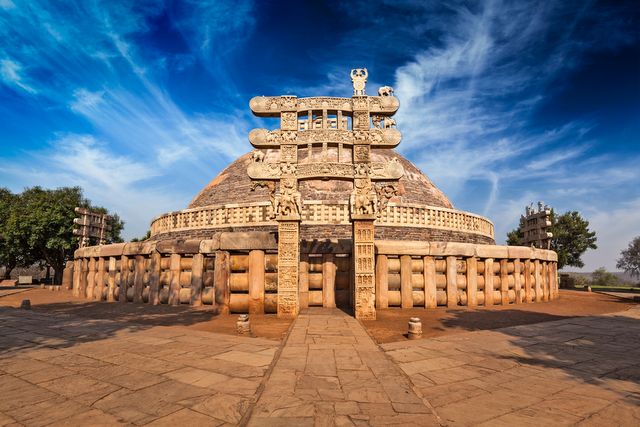Sanchi, located in the Raisen district of Madhya Pradesh, is a UNESCO World Heritage site renowned for its ancient Buddhist stupas, monasteries, and other architectural wonders. The site holds immense historical and religious significance as it is closely associated with the life and teachings of Lord Buddha. Here’s a closer look at what makes Sanchi a captivating and spiritually enriching destination:
Great Stupa: The Great Stupa of Sanchi is the most iconic structure at the site, built during the reign of Emperor Ashoka in the 3rd century BCE. It serves as a central point of pilgrimage and devotion for Buddhists from around the world.
Ancient Relics: The stupas at Sanchi house sacred relics of Lord Buddha, attracting pilgrims and visitors seeking spiritual blessings and a connection to the founder of Buddhism.
Intricate Carvings: The stupa’s toranas (gateways) are adorned with exquisite carvings that depict scenes from Buddha’s life, Jataka tales, and symbols of the Dharma (Buddhist teachings).
Ashoka Pillar: The Ashoka Pillar, originally erected by Emperor Ashoka, stands as a testimony to his patronage of Buddhism. It features edicts that convey his commitment to non-violence and social welfare.
Monasteries and Temples: Explore the remains of monasteries, temples, and other structures that were once part of the bustling Buddhist complex, providing insights into the daily lives of monks and devotees.
Archaeological Museum: Visit the Sanchi Archaeological Museum, which houses a collection of artifacts and sculptures found at the site, offering a deeper understanding of its historical context.
Peaceful Environment: Experience the serene and tranquil atmosphere of Sanchi, where you can reflect, meditate, and find solace amidst the ancient relics.
Spiritual Pilgrimage: Sanchi is a significant pilgrimage destination for Buddhists, who visit to pay homage to Lord Buddha and deepen their understanding of his teachings.
Cultural Heritage: Gain insights into the rich cultural heritage of India, as Sanchi’s architecture, art, and inscriptions provide a window into the country’s ancient past.
Architectural Marvels: Appreciate the architectural excellence of the stupa and its intricately carved gateways, showcasing the artistic achievements of ancient India.
Global Recognition: Sanchi’s historical and cultural importance has gained recognition on the global stage, contributing to its status as a UNESCO World Heritage site.
Educational Experience: Delve into the history of Buddhism, the Mauryan dynasty, and the spread of Buddhist philosophy as you explore the site.
Religious Symbolism: Interpret the symbols, carvings, and inscriptions that convey the core principles of Buddhism, such as compassion, wisdom, and the Eightfold Path.
Photography: Capture the timeless beauty of the stupa, its surrounding landscape, and the intricate carvings that adorn its gateways.
Mindful Contemplation: Sanchi provides a conducive environment for mindful contemplation and introspection, allowing visitors to connect with their inner selves.
Harmony with Nature: Experience the harmonious blend of the stupa’s architecture with the natural surroundings, creating a sense of unity and peace.
Interfaith Interest: Sanchi’s historical significance extends beyond Buddhism, attracting individuals interested in exploring the intersections of various faiths and cultures.
Living Heritage: Despite its ancient origins, Sanchi remains a living heritage site where visitors can engage with history and spirituality in a tangible way.
Sanchi’s remarkable architecture, spiritual significance, and connection to the teachings of Lord Buddha make it a place of profound reverence and contemplation. As you walk amidst the ancient stupas and absorb the timeless wisdom they embody, you’ll find yourself drawn into a spiritual journey that transcends time and space.

